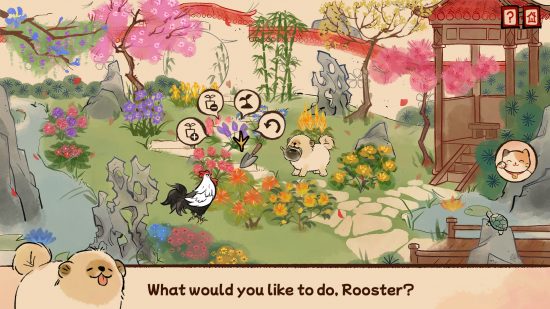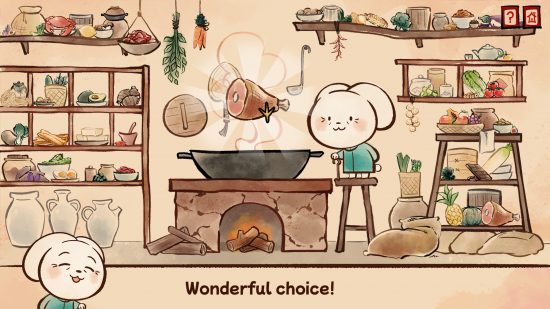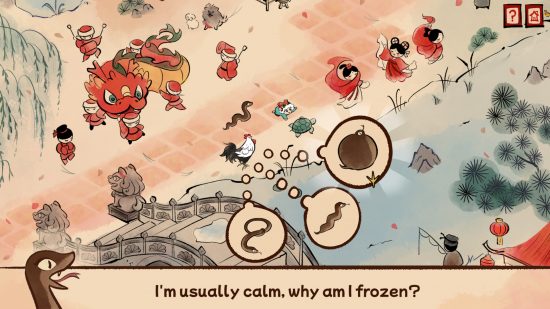Celebrating crafting, cozy games, and culture with the Rooster team

With so many amazing announcements and new games to try out, it’s impossible to see everything at GDC. That’s why we were delighted to catch up virtually with Sticky Brain Studios, the dev team behind Rooster, after their game’s debut at the conference.
Rooster is a casual, cozy puzzle game with beautiful handcrafted illustrations in the style of Chinese brush paintings. The game takes place in Ancient China, where you play as the titular Rooster from the Chinese zodiac. You must make amends with your fellow zodiac animals, all while witnessing a human baby named Little Dove experience life’s important milestones. Set for a 2025 release, you can currently wishlist Rooster on Steam, and a Nintendo Switch release is on the cards.
According to Sasha Boersma, Co-Founder of Sticky Brain Studios, “Rooster is what happens when artists have a platform to celebrate their heritage with the full-backing of a multicultural team.” We spoke to writer and narrative designer Deborah Chantson, and creative lead Connie Choi, about the process of making such a beautiful and personal game.
How has the desire to make your game accessible and inclusive influenced its development? What features can we expect in the full version?
Deborah Chantson: I have every plan for all the accessibility features possible and I’d be so disappointed if scope is the thing that has to limit us in the end. But I want people to know that six of us are certified accessible player experiences practitioners. So these conversations that we’re having in our planning of the game are really important. It’s not an afterthought in any way possible.
We’re putting in content warnings for heavy, emotional moments, and we’re also thinking about font size and how our UI looks and if you need to enlarge that font, or you know, how is that going to fit with their character count and what’s your maximum and minimum. So I’m actually writing dialog to fit these character counts! We’re also big into thinking about second channels. “If somebody wasn’t able to read this, would they be able to hear it instead? And how would that pick up on screen readers?” The goal is to have voiced text, at least for English.
I’m trying to write the characters as if they are non-binary (except for Rooster, because Rooster is obviously a dude). I’m actually avoiding using pronouns at all, so all the characters are referred to as their name. I know that for localization that might not necessarily fly in terms of like [gender-neutral pronouns], like in Chinese, it’s not really a thing yet, but in French it is, you have iel and ielles. So that’s why all the characters are referred to by name. It’s a very conscious decision.

Connie Choi: We’re gonna have difficulty scaling, because there are very different types of puzzles that we’re fitting in. Maybe there are certain puzzles that people are more inclined toward, and some of them that they’re not. There are lots of options to skip as well, so that people with different backgrounds and experiences – and interests even – could choose to engage or not, but still experience the story.
DC: It’s written into the dialogue in a very peaceful attitude. Like, “I think you’ve had enough of this. Would you like to move on? I’m okay with that.”
Everyone on the Pocket Tactics team fell in love with the art style of Rooster. Are there any specific artists or artistic periods that influenced the team when creating the visuals for the game?
CC: Because I set the style, a lot of it is personal influences combined with the general art style that I think would fit best with this type of game and story. I went for an art style that would bring some level of nostalgia or familiarity for people who are familiar with Chinese ink brush painting. There’s a bit of a storybook about quality to it as well, and some manga influence.
Leading on from the previous question, hand-drawn artwork is becoming more and more rare in both the gaming and animation industries. Did you face any challenges in creating such a beautifully detailed, hand-drawn world? Why was it important to you to showcase this artform?
CC: There’s a simple answer – I like drawing! The handcrafted part of it is very important to me because it’s just how I create. I’ve never dabbled in generated art or all that, this is just how I know how to do things.
As for challenges, choosing a style that you can teach other people to do was an interesting task because I chose a fairly difficult style to master, mostly because there are limitations like palette restrictions, but also it’s a very intuitive style where you can break the rules sometimes and it works beautifully. I think that the main challenge was communicating how to replicate it. It looks simple, but there’s a lot of subtlety to it, that if deviated too far just wouldn’t look like the Rooster style.
If it’s quite an intuitive style, you have to know the rules, but then you have to know the rules in order to break them.
CC: Exactly! That was a very big challenge, but the artists that I had helping me on this project are so talented and very amazing. When they learned it, they were able to take off and make their own interesting choices based on it. It’s beautiful and the game looks very cohesive as well because of it.
How (if at all) are the minigames a reflection of their related zodiac animal?
DC: I’ve taken a smidgen of the characteristics – which I think are totally random by the way! – and for what we have identified as something to latch on to, we’ve worked with that or turned it on its head, and that’s how we got the mechanic for each level. We’ve tried to make them as positive and relatable as possible.
CC: What animal are you? I’m a dog.
I was born in 1997, so I’m an ox!
DC: Ox is a loyal and dependable friend!
From the looks of your website, this is Sticky Brain’s first PC/console game. Why is Rooster the first to “fly the nest” of mobile?
CC: I think it was probably the funding [from Canada Media Fund and Ontario Creates].
DC: It worked out well for being able to demonstrate why this will work as a larger-scale game and get the prototype funding. It’s unique enough to hit that mark – it needs to be this scale for this purpose. But we are in talks about putting it on larger-sized mobile devices later.
CC: I’m primarily a mobile gamer, so if Rooster does come out on my phone, I’ll be like, “Oh, finally. Yes.”
DC: We’re in talks with the [console] platforms. What I’ve said about the Switch is that because there’s the tactile nature of the screen and stylus capability, that would be great for being able to have a more tactile experience that other platforms can’t necessarily offer.
With point-and-click games having such a rich history over the last thirty years, did you take any inspiration from any particular games?
DC: There’s a Beauty and the Beast game from around 1994 that has eggs that you shoot across the screen and the eggs bounce in an obstacle course. There’s a little bit of that and one of the levels!
CC: Brothers: A Tale of Two Sons – I cried so much, it’s very good. I was very interested in the variety of mechanics you could achieve just from pointing and clicking. That was something I initially wanted to explore with Rooster as well.
I’ve read about how the Rooster team is very diverse, with a lot of people from specifically Chinese backgrounds. What advice would you give to other indie developers who might be afraid of putting aspects of their marginalized identity into their work?
DC: Don’t feel like the onus is on you to represent all of your culture everywhere from the beginning of time. You just have to represent it the best that you know it, and if you need to pull somebody in for backup, then do that. But also, you don’t have to make the game for everybody. Make the best game that you can and do your best and make sure it’s fun for you. I’m very much writing a game that I want to play.
CC: If you’re making a game that connects with yourself, there’s a good chance that someone out there will connect with what you connect with. Personally, I’m putting in something that is very niche even within Chinese cultures. There’s a more niche food in there and I don’t feel any fear putting it in there. That’s probably because I trust that someone out there will connect with it, and if they know, they know, that’s pretty much it. I think it’s a choice to celebrate your culture.
That’s all we had time for in our chat with the Rooster team. We can’t wait to check out the game when it comes to the Switch (and maybe mobile) in 2025. In the meantime, make sure you follow Sticky Brain Studios on social media and wishlist Rooster on Steam to show your support.
While you’re here, make sure to check out our lists of the best dog games, chicken games, and dragon games to familiarize yourself with the zodiac gang. We’ve also got a great list of point-and-click games for Switch and mobile.





